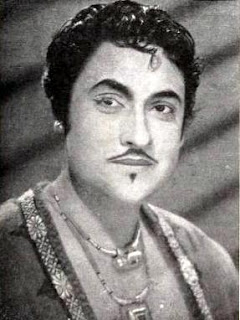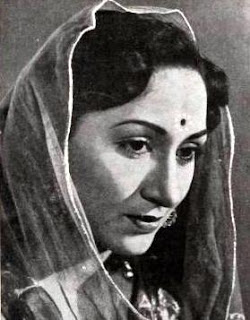Producers: Filmistan Ltd.
Language: Hindustani
Story: Gyan Mukherji
Screen Play & Dialogue: Saadat Hasan Manto
Photography: S. Hardip
Audiography: J. G. Jagtap
Editing: Dattaram Pai
Lyrics: Gopal Singh Nepali
Music: Sachindev Barman
Cast: Ashok Kumar, Veera, Paro, Rama Shukul, Leela Misra, V. H. Desai, Kishore Kumar etc.
Released At: Roxy, Bombay.
Date of Release: 5th January 1946.
Directed By: Savak B. Vacha
It is a pity that a new company like Filmistan Limited should be compelled to produce a propaganda picture months after the war, and compromise its chances of commercial success as producers. Though "Shikari,' as a theme, hasn't got anything special in it, it would certainly have made a better picture had the producers not been compelled to mix in it propaganda contents. And yet due to smart takings and smarter editing the picture has been made fast enough to ho!d the interest once you make your peace with its poor story and propaganda material.
Cheap Jap Stuff
One wonders how long the Japanese are going to be the theme of our pictures now that the war is over. "Shikari" is another Jap story thrown into a town of Burma with a crowd of villagers and a small family of a dozen persons. Throughout the picture we see nothing of Burma or the Burmese. We are asked to identify the whole of Burma and everything Burmese in the small group of players who enact the plot of the story.
As the story unfolds itself on the screen we are faced by the fact that neither Gyan Mukerji nor Saadat Hasan Manto could make up their mind about the exact theme of the play. "Shikari" is therefore a propaganda story, a socialistic theme, a freedom struggle and what not, all in one and all in bits.
There is the usual Zamindar Rajnarayan with a daughter called Veena and a suitor for her called Ranjit. They are all rich. The other group consists of Badal, a Chieftain with Paro, a jungle girl, in love with him and Masterji, an old go-between, between the two groups. With this pattern of characters romance is given to the story in which Ranjit wants to marry Veena while Veena is in love with Badal. Ranjit becomes the villain on the male side and Paro becomes the jealous cat on the female side. These two erect the usual hurdles in the race of romance between Badal and Veena, and the romantic theme travels in its usual rut without either Gyan Mukerji or Saadat Hasan Manto showing any imagination about it.
Just at this stage the Government of India step in with their Japanese prize boys and call upon the hero and the heroine to get mixed up in their war propaganda. So we are introduced to a Japanese Captain who talks some Hindustani billingsgate, shoots a lot ot people, manhandles a lot of girls and bleeds a number of children. Very soon the whole atmosphere is transtormcd into a guerrilla warfare and wc see Veena becoming a guerrilla leader and Ranjit and Badal running between her and the Japanese at regular intervals. In keeping with our expectations the Japanese are driven out, two interfering players, Ranjit and Paro, are disposed off and Veena and Badal are thrown into an embrace of romance, not only as lovers but as patriots in addition.
The picture fails to attract mainly because of poor story material and its subsequent development. We do not know who this fellow Saadat Hasan Manto is, and he seems to be a new man at the game, but his work as a screen-play and-dialogue-writer seems to be terrifically poor. He fritters away several opportunities where he could have given very powerful dialogues which would have added a theme and drama to the situations. It is mainly because of the poor work of this man that the story fails to appeal. The only saving grace is the editing of Dattaram Pai which is remarkably slick and fast throughout the picture. The photography is good in parts and rather dark at places. Sound recording is very faulty and indistinct, and many dialogues are lost entirely to the audience. The lyrics of Gopal Singh Nepali are quite good and written in a very simple language with words which help musical phonetics. The musical tunes, however, must be considered as very poor. The sets are remarkably good.
Savak Vachas direction is good work as a maiden effort and this boy promises to be a good director in future if he is given a carefully written scenario. In "Shikari" he shows sufficient imagination in shot composition and action direction.
Veera, A New Find
From the players Ashok Kumar, who is a vastly improved artiste these days, once again gives a good performance as 'Badal,' the hero of the story. He is less effeminate these days and more graceful, and his performance, therefore, becomes immediately popular.
Veera is an excellent addition to the screen heroines of India. She is surprisingly good in light portrayals and is hardly camera-conscious. The only defect found in her at present is her faulty diction of the dialogue which she stammers out in a painful manner. It will be more beneficial to avoid this girl in big close-ups and generally present her in small midshots. Veera has a good figure and shows enough talent to be a very useful artiste in future.
Paro, another new-comer who plays the jungle girl, is utterly useless as a screen artiste. She is dwarfish in figure and has deformed legs which look repulsive. Though the girl makes a sincere effort to portray her role, her appearance goes against her throughout and she fails to win the sympathy of the audience.
Rama Shukul acts Ranjit, the weak-kneed villain of the piece, but while doing so he speaks more to himself than to any one in the picture or in the theatre. Excited or not it is difficult to pick up Shukul's dialogue which piles up one over the other in his unholy hurry to vomit it.
This is Shukul s main defect which makes him highly unsuitable for screen work though in all other respects he is quite a good artiste. Leela Misra in the role of Sunalini, the mother of Ranjit, gives a good performance. V. H. Desai, the comedian of the play, has little to do and proves boring these days with his usual monkey tricks.
From the Jap quarters Samson attracts attention by his excellent performance as the Japanese Captain. This is perhaps the best Japanese Captain seen by us on this side of the Burmese border since Indian producers started doling out Jap themes. Samson certainly deserves encouragement.
To sum it all up, "Shikari" is not at all a bad picture if you once make peace with its thin story material and its propaganda contents. Thanks to Dattaram Pai. the editor, the picture has been made fast and saved from being a complete piece of boredom. "Shikari" is not a bad time-killer.
 |
| Paro in Shikari |
 |
| Ashok Kumar in Shikari |
 |
| Veera in Shikari |
 |
| Ashok Kumar and Paro |
 |
| Veera |
 |
| Paro in Shikari |


